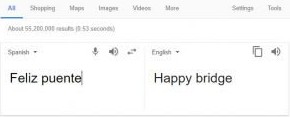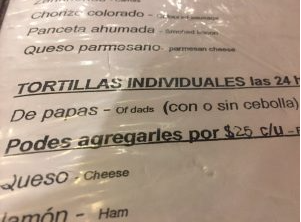Google translate como mi traductor de confianza, ¿en serio? (Google translate as my go-to translator, for real?)
¡Buenas!
Hoy quería hablaros de algo que todos hemos usado alguna vez y es el Google Translate. Para muchos es la herramienta perfecta para traducir cualquier palabra, frase (o incluso párrafo) a cualquier idioma como puede ser el inglés. Y la verdad es que suele funcionar relativamente bien pero claro hay un pequeño problema. Si usamos el Google Translate como nuestro traductor de confianza para absolutamente todo sin siquiera revisar si está bien y es coherente dejadme deciros que...vais a tener complicaciones.
Esta traducción puede parecernos de broma pero ha pasado de verdad. Y aunque creo que si nos pasa esto está claro que no le hacemos caso e intentamos buscar una buena traducción en otra página, hay errores que igual no nos parecen mal en un principio o que si vamos con prisas ni lo revisamos y luego a la hora de entregarlo o corregirlo en clase pasamos un mal rato por las barbaridades que hemos escrito gracias al Google Translate. Hay varios errores habituales que este traductor sufre:
- Tiene un vocabulario relativamente escaso, y suele traducir todo de manera literal. Esto hace que frases hechas, expresiones o algunos phrasal verbs no los traduce de manera correcta.
- No procesa muy bien las polisemias. Tanto en español como en inglés, usamos una misma palabra para muchos significados o contextos y el Google Translate no procesa muy bien estas diferencias, por lo que muchas veces puede llevarnos a la traducción errónea de la palabra en el significado que buscamos.
- Muchas veces hace traducciones enrevesadas. Si usamos Google Translate para traducir frases largas o párrafos, muchas veces puede dar lugar a traducciones complicadas o incluso imposibles de entender por lo enrevesadas que parecen.
Personalmente, y creo que muchos de mis compañeros filólogos o traductores están de acuerdo, Deepl es de mis favoritos a la hora de ayudarme a traducir. Tiene mucha más riqueza de vocabulario que Google Translate y, si a la hora de ver la traducción, esa palabra no te convence o no estás seguro de que sea la correcta, solo pinchando en la palabra te da muchas más opciones de traducciones posibles que esa palabra puede tener.
En conclusión, Google Translate puede sacarnos de algún apuro en algunas situaciones, pero también puede meternos en un lío con sus dudosas traducciones. Así que, como consejo, echadle un ojo a otras herramientas ya que os pueden sorprender y servir para un futuro.
Os dejo por aquí algunas traducciones erróneas que han salido de Google Translate, ya que son bastante graciosas.
See ya :)
(English translation)
Hello!
Today I wanted to talk to you about something we all have used at some point and that is Google Translate. For many it is the perfect tool to translate any word, phrase (or even paragraph) to any language such as English. And the truth is that it usually works relatively well but of course there is a slight problem. If we use Google Translate as our trusted translator for absolutely everything without even checking if it is right and consistent let me tell you... you are going to have complications.
This translation may seem like a joke but it really happened. And although I think that if this happens to us it is clear that we ignore it and try to find a good translation on another site, there are errors that may not seem wrong at first or that if we are in a hurry we do not even check it and then when it is time to hand it in or correct it in class we have a hard time because of the nonsense we have written thanks to Google Translate. There are several common errors that this translator suffers from:
- It has a relatively small vocabulary, and tends to translate everything literally. This means that idioms, expressions or some phrasal verbs are not translated correctly.
- It does not process polysemias very well. Both in Spanish and English, we use the same word for many meanings or contexts and Google Translate does not process these differences very well, so it can often lead to the wrong translation of the word in the meaning we are looking for.
- Many times it makes convoluted translations. If we use Google Translate to translate long sentences or paragraphs, it can often lead to complicated translations or even impossible to understand because of how convoluted they seem.
Personally, and I think many of my fellow philologists or translators agree, Deepl is one of my favorites when it comes to helping me translate. It has a much richer vocabulary than Google Translate and, if when looking at the translation, that word does not convince you or you are not sure if it is the right one, just clicking on the word gives you many more options of possible translations that word may have.
In conclusion, Google Translate can get us out of trouble in some situations, but it can also get us into trouble with its dubious translations. So, as a tip, keep an eye on other tools as they may surprise you and be useful for the future.
I leave here some mistranslations that have come out of Google Translate, as they are quite funny.
See ya :)







¡Me ha encantado tu entrada! DeepL también es mi mejor amigo como traductora. Recuerdo haber intentado usar Google Translate para traducir unas frases en japonés y me estaba tomando el pelo, diciendo que "todos los días" en japonés se decía "kadadia". Me han hecho mucha gracia las traducciones que has incluido al final, ¡menos mal que ya no usamos Google Translate tanto!
ResponderEliminarComo compañera filóloga opino igual que tú, mucha gente recurre a google translate porque no conoce otras herramientas mejores pero tampoco tienen los conocimientos necesarios para saber si la traducción que reciben tiene sentido o no. En conclusión, viva san DeepL.
ResponderEliminar